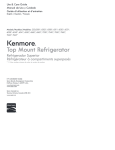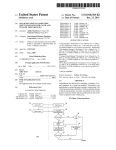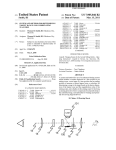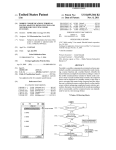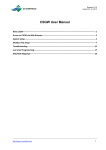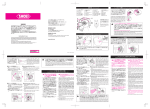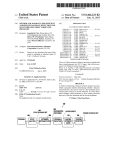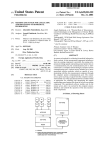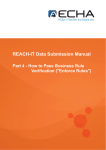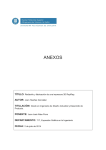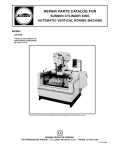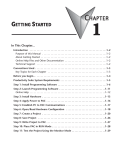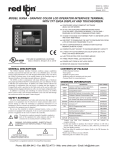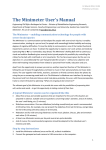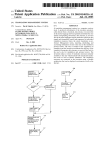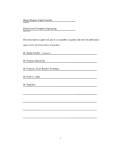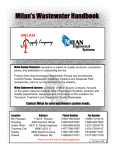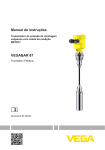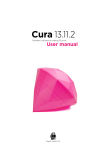Download Apparatus, system and method for measuring the properties of a
Transcript
US008794061B1 (12) United States Patent Sickels, Jr. (54) APPARATUS, SYSTEM AND METHOD FOR MEASURING THE PROPERTIES OF A (56) U.S. PATENT DOCUMENTS 4,916,426 5,325,716 6,378,362 6,687,643 6,712,138 7,735,378 (71) Applicant: Ultra Analytical Group, LLC, League City’ TX (Us) (72) Inventor: Robert Eugene Sickels, Jr., Mans?eld, TX (US) (73) Assignee: Ultra Analytical Group, LLC, League City’ TX (Us) Notice: Aug. 5, 2014 References Cited CORROSIVE LIQUID (*) US 8,794,061 B1 (10) Patent N0.: (45) Date of Patent: 2004/0200287 2009/0056422 2009/0285721 2012/0097388 2012/0193090 4/1990 7/1994 4/2002 2/2004 3/2004 6/2010 10/2004 3/2009 11/2009 Yajima et al. ................... .. 338/4 4/2012 Beck ...................... .. 166/25007 Hafner et al. .. 73/301 Dickinson .... .. 73/152.28 Cason, Jr. ................... .. 702/137 Mandal Sing?eld et a1. Mueller et al. ................ .. 73/715 Quinn et al. ............... .. 73/53.01 DeGreeve et al. 8/2012 Lopez De Cardenas 166/250.01 (Continued) Subject to any disclaimer, the term of this patent is extended or adjusted under 35 FOREIGN PATENT DOCUMENTS U.S.C. 154(b) by 0 days. 2012000044 A1 2012061872 A1 (21) Appl. N0.: 14/096,444 1/2012 5/2012 OTHER PUBLICATIONS (22) Filed: Dec. 4, 2013 Vega, Process pressure/ Hydro staticiPressure measurement, 3 5400 - EN-090130 (63) from www.vega.com/d0wnloads/BN35400-EN Vegawell52ProductInformation.PDF. Related US. Application Data Continuation of application No. 14/046,118, ?led on Oct. 4, 2013. (Continued) Primary Examiner * John Fitzgerald Assistant Examiner * Marrit Eyassu (51) Int. Cl. EZIB 49/00 G01N 9/26 (52) (74) Attorney, Agent, or Firm * Colin P. Cahoon; Brandon (2006.01) (2006.01) V. Zuniga; Carstens & Cahoon, LLP (57) US. Cl. CPC ...................................... .. G01N 9/26 (2013.01) USPC (58) ........................................ .. 73/152.05; 73/451 Field of Classi?cation Search CPC . G01N17/008; G01N 17/04; G01N 2009/26; G01N 2009/63; G01N 9/00; G01N 9/36; G01N 9/26; G01N 9/32; G01N 9/12; G01N 9/18; G01N 9/10 USPC ..................................... .. 702/9; 73/32 R4454 ABSTRACT An apparatus and method used to determine the density and other properties of a corrosive liquid, such as drilling mud. The apparatus uses at least two sensor elements with ceramic facings spaced a known vertical distance apart and inserted into the ?uid. The differential pressure measurement pro vided by these sensors is used to calculate the density of the liquid. This density measurement is then reported in real-time to an operator. See application ?le for complete search history. POWER 314 | 14 Claims, 5 Drawing Sheets l l | : SUPPLY : MONITOR | CONTROL I | l l BOX 404 406b 412D hZ 408b 412a D 406a 400 J TE); 1m | I US 8,794,061 B1 Page 2 References Cited Click Koyo, Click CPUs, C0-00DDl-D CPU from WWW.aboutplcs. U.S. PATENT DOCUMENTS com/clicldHardware/CPU-Modules/c0-00dd1-d.html. Emerson Process Management4Oil?eld Services from WWW2. (56) 2012/0204636 2013/0199286 2013/0291620 2013/0298663 A1* 8/2012 Teli et al. A1* 8/2013 Gao et al. A1 11/2013 Sing?eld A1 11/2013 Sing?eld 2013/0298696 A1 2014/0007668 A1* emersonprocess.com/en-US/brands/micromotion/industries/oil ...................... .. 73/309 ................. .. 73/152.27 11/2013 Sing?eld 1/2014 Shanks .................... .. 73/152.51 and-gas/oil?eld-services/drilling-?uidsmanagement/Pages/ Index. ast. MudAutomatics screen shot from WWW.mudautomatics.com/ . The Mud Weight Watcher, Transforming Weight Control from W. mudautomatic s . com/ . VegaiVegawell 52iSpeci?cation Sheet, 34734-EN-0910008 from OTHER PUBLICATIONS Vega, Process pressure/Hydrostatic4Operating instructions, 3 5401 EN-111021 from WWW.V€ga.COII]/ClOWIllO€1ClS/BA/35401-EN VegaWell.PDF. The Mud Watcher, Transforming Mud MonitoringiSpeci?cations from WWW.mudautomatics.com. Red Lion G3 06 from WWW.V€ga.COIIl/ClOWIllO€1ClS/BA/34734-EN Well52Speci?cationSheet.PDF. VegaiVegawell 524Operating Instructions, 4 . . . 20 mNHART Pt 100, 35402-EN-111021, Document ID 35402. MezurX Products and ServicesiMud SentriX, printed Feb. 27, 2014, located at: http://WWW.mezurX.Com/Mudsentrixphp, 4 pages. MD3018 Mud Density Remote Seal Differential Pressure Transmit emersonprocess.com/en-US/brands/micromotion/industries/oil and-gas/oil?eld-services/drilling-?uids-management/Pages/Index. ter for Drilling Mud Density and Cement Density Measurements, Industrial Pressure Products, Speci?cations, 2005 AMETEK, Inc., 5M0103T (210057). MD3018 Series Mud Density Transmitter, Installation/User Manual, AMETEK, Revision C, May 2000, pp. 1-14. MD3018 Mud Density Transmitter4OvervieW, AMETEK. ast. Auto Wate Drilling Solutions screen shot from WWW.autowate.com. * cited by examiner WWW.redlion.net/Products/ HumanMachineInterface/OperatorInterfac e/G306 .htrnl. Denver Smart et al. “Micro Motion White Paper” Emerson Process Management, Micro Motion, WP-001243, Rev. B, 2013 from WWW2. US. Patent Aug. 5, 2014 US 8,794,061 B1 Sheet 1 0f 5 POOL MUD COLLECT SAMPLE WEIGH SAMPLE CALCULATE DENSITY REPORT DENSITY FIG. 1 POOL MUD (Prior Art) INSERT ASSEMBLY w 204 D ETECTI ON STEP \- 206 TRANSMISSION OF RAW DATA STEP DATA CONVERSION STEP TRANSMISSION OF RESULTS FIG. 2 US. Patent Aug. 5,2014 Sheet 2 0f5 US 8,794,061 B1 USER 302 A INTERFACE l l l l 304 —/\: l l l | J— 308 MONITOR 306 _/\ _________ _ _ SENSOR CONTROL BOX ASSEMBLY ................................. .. 312 POWER SUPPLY FIG. 3 m 314 ,\_ 310 US. Patent Aug. 5,2014 Sheet 5 015 US 8,794,061 B1 US 8,794,061 B1 1 2 APPARATUS, SYSTEM AND METHOD FOR MEASURING THE PROPERTIES OF A and the mass of the mud. Fifth, the mud’s density is reported to the drilling operator 110. This will permit the drilling operator to make adjustments to the mud’s density if it is CORROSIVE LIQUID outside of a desirable density range and can provide useful information on down-hole conditions. CROSS-REFERENCE TO RELATED APPLICATION There has been no reliable, real-time method of determin ing the density of drilling mud. The old mud scale was the most reliable and simple way of making the determination, but it does not provide real-time data. For example, when drilling a well a mud sample typically will be drawn and This application is a continuation of and claims ?ling pri ority rights with respect to currently pending US. patent application Ser. No. 14/046,118, ?led on Oct. 4, 2013. density will be calculated once every hour for on-shore wells and once every 15 minutes for off-shore wells. Thus, if a mud BACKGROUND OF THE INVENTION density ?uctuates soon after a sample is taken, it may be 20 minutes before a drilling operator realizes that the density 1. Technical Field ?uctuation has occurred. This in turn may leave little time for The present invention generally relates to measuring at least the density of a corrosive liquid by using at least two implementing corrective measures to keep the mud density in a safe range or for taking other corrective measures to shut a submerged corrosion resistant pressure sensors that are sepa well down. Accordingly, a device capable of measuring mud density in real-time is desirable for the additional safety, reliability, and e?iciency it can provide. rated by a known vertical distance. The corrosive liquid may be erosive, abrasive, fouling, caustic, basic, acidic, capable of damaging sensors, or any possible combination thereof. In particular, the invention relates to an apparatus, system, and method for measuring the density of a corrosive liquid, such as drilling mud, by using at least two corrosion-resistant pressure sensors submerged in the corrosive liquid and sepa 20 rated by a known vertical distance to obtain at least two 25 proven unreliable when operating under the corrosive, ero sive, abrasive, fouling, caustic, basic, acidic or other harsh conditions imposed by drilling ?uids. Drilling mud is typi pressures at different depths in the corrosive liquid. sensors. For example, the mud contains solids, including With the discovery of new drilling techniques such as hydraulic fracturing, the United States is currently experienc 30 with new techniques, many more wells are being drilled with tried and true techniques. All told, thousands of wells are being drilled every year in the United States alone. In every solids in the mud and well cuttings that can be abrasive or erosive. These solids can scrape a sensor and damage it. The mud also tends to be basic, which can damage a sensor by eating away at the sensor. Additionally, the mud can form layers on a surface that are di?icult to remove. If the mud forms layers on the sensor, the sensor may become fouled and one of these wells, drilling ?uids such as muds, cements or other slurries play an integral role in ensuring a safe and cally made up of water, clay, and additives used to modify the mud’s viscosity, density, pH and other properties. The mud creates an environment that is not conducive to prior art 2. Background ing an energy bonanza. In addition to the wells being drilled Although some existing devices such as Coriolis and Ven turi ?owmeters can provide real -time density data, they have fail to work properly. 35 What is needed is a new and innovative device capable of e?icient drilling operation. For example, drilling mud is use ful for controlling well formation pressures, removing well the harsh conditions involved in drilling. For example, a need cuttings, and facilitating the cementing and completion of exists for an apparatus that can measure the density of mud or wells. Perhaps one of the most important functions of drilling muds is to help to prevent potentially devastating oil well blowouts. However, drilling muds are only effective at pre venting blowouts when their properties, such as density, are autonomously transmitting real-time density data even under other liquids every second of every minute during the drilling 40 tors with density data that is extremely accurate. Accordingly, the risks and liability associated with drilling wells could then be reduced while the reliability and ef?ciency of the drilling process is simultaneously increased. For example, there properly adjusted. Real-time measurement of drilling prop erties is also used to help the rig operator understand down hole conditions. Consequently, being able to measure the properties of these ?uids while a well is being drilled is critical. Up until now, traditional mud scales or balances have been used to measure the density (weight) of drilling ?uid, cement, or any other type of liquid or slurry. Typically, the mud scales 45 50 on a drilling site consist of a graduated beam with a bubble level, a weight slider along its length, and a cup with a lid on the end. The cup is used to hold a set amount of liquid to be energy e?icient, using for example, using only 24 watts of power. As a result, the embodiment can run off of back up cost-savings. It would also be bene?cial if such apparatus were highly 55 portable, comprising, a light-weight, compact unit. Such, a unit could be ?own to remote locations by light aircraft or the scales are not pressurized, but a pressurized mud scale 60 A method for employing a traditional mud scale will now be described with reference to FIG. 1. First, mud is pooled, for example in a tank, in a pooling step 102. Second, a sample of shipped at low costs due to its compact size and light weight. Furthermore, if the unit were constructed from weather-proof components and the mud probes were made from highly durable industrial materials, the unit would be capable of standing up to the rigorous conditions encountered at many drilling sites. SUMMARY OF THE INVENTION the mud is collected in a known volume in a collection step 104. Third, the mud is weighed in a weighing step 106 to obtain the mass of the mud. Fourth, the mud’s density is calculated in a calculation step 108 using the known volume intercoms. Instead, operators could receive real time read outs of mud density and have peace of mind that a drilling ?uid is operating within a safe density range. It would also be bene?cial if such apparatus were highly charge. This is desirable for both environmental bene?ts and sity (often water) and adjusting a counter weight. Generally, operates in the same manner. would no longer be a need to call out mud weight over battery power for long periods between charging by a solar weighed. The slider weight can be moved along the beam and a bubble indicates when the beam is level. Density is read at the point where the slider weight sits on the beam at level. Mud scales are calibrated by using a liquid of known den process and then transmit the measured data to provide opera 65 The present invention generally provides for an apparatus, system, and method for measuring at least the density of a US 8,794,061 B1 3 4 corrosive liquid, for example a drilling mud, by using at least industrial materials, the unit is capable of standing up to the rigorous conditions encountered at many drilling sites. two submerged corrosion resistant pressure sensors that are separated by a known vertical distance. The corrosive liquid BRIEF DESCRIPTION OF THE DRAWINGS may be erosive, abrasive, fouling, caustic, basic, acidic, capable of damaging sensors, or any possible combination The novel features believed characteristic of the invention are set forth in the appended claims. The invention itself, however, as well as a preferred mode of use, further objectives thereof. The corrosion resistant sensors may be constructed, for example, from sensor elements that comprise ceramic components. The invention further provides for optionally and advantages thereof, will be best understood by reference to the following detailed description of illustrative embodi ments when read in conjunction with the accompanying measuring one or more other liquid properties, for example viscosity, pH, salinity, chloride content, and H2S concentra tion. The invention further provides for conducting other types of analysis, such as measuring physical or chemical drawings, wherein: FIG. 1 is a ?ow chart representation of a prior art process properties. for obtaining the density of a drilling mud. FIG. 2 is a ?ow chart representation depicting the overall In a ?rst aspect, the invention provides an apparatus that can measure a corrosive liquid’ s density by using at least two corrosion-resistant pressure sensors submerged in the corro process of one embodiment of the invention. FIG. 3 is a schematic depicting a system that is one sive liquid and separated by a known vertical distance to embodiment of the present invention. FIG. 4A depicts a perspective view of one embodiment of obtain at least two pressures at different depths in the corro sive liquid. 20 In a second aspect, the invention provides a system com prising a power supply, a Monitor Control Box (MCB) and at least two corrosion-resistant pressure sensors that are spaced a known vertical distance apart in a sensor housing and are in electronic communication with the power supply and the a sensor assembly according to the invention. FIG. 4B depicts a perspective view of another embodiment of a sensor assembly according to the invention. FIG. 4C depicts a perspective view of one embodiment of a sensor housing according to the invention. 25 MCB. In a third aspect, the invention provides a method compris DETAILED DESCRIPTION OF THE INVENTION ing the steps of pooling a corrosive liquid, inserting into the One embodiment of a method according to the invention will now be described with reference to FIG. 2. First, mud is liquid an apparatus comprising at least two corrosion resistant pressure sensors that are separated by a known distance, using 30 sures of the liquid corresponding to a minimum of two dif ferent liquid depths that are separated by the known distance, transmitting data comprising the at least two different pres separated by a known vertical distance given by subtracting 35 sures to a device capable of converting the pressure data to a Third, in a detection step 206, the pressures of the liquid at each of the sensors are measured to provide at least two 40 The inventor has developed a new and innovative device even under the harsh conditions involved in drilling. For each of the sensors, are transmitted to a Monitor Control Box example, one embodiment of the invention can measure the data to provide operators with density data that is extremely accurate. Accordingly, the risks and liability associated with drilling wells may be reduced while the reliability and ef? ciency of the drilling process are simultaneously increased. For example, there is no longer a need to call out mud weight over intercoms. Instead, operators may receive real time read outs of mud density and have peace of mind that a drilling ?uid is operating within a safe density range. Another bene?t of the invention is that one embodiment is 45 (“MCB”). The MCB may comprise, for example, a compu tational device. The term computational device includes but is not limited to a central processing unit (“CPU”), a program mable logic controller (“PLC”) and a computer. Alternatively, 50 the MCB may comprise, for example, a PLC and a computa tional device. During the transmission of raw data step 208, the raw data is transferred by electronic communication, for example, by wired communication, wireless communication, radio, WiFi, Bluetooth, cable, or optical ?ber. In one embodi ment, the raw data may be transferred from the sensors to the 55 highly energy ef?cient, using for example, only about 24 watts of power. As a result, the embodiment can run off of back up battery power for 36 hours in addition to running for 24 hours without a solar charge. This is desirable for both environmental bene?ts and cost-savings. Another embodiment of the invention is highly portable, comprising, a light weight compact unit. This unit may be ?own to remote locations by light aircraft or shipped at low costs due to its compact size and light weight. Furthermore, because the unit can be constructed from weather-proofcom ponents and the mud probes can be made from highly durable pressures at liquid depths that are separated by the known vertical distance. Thus, the known vertical distance is equal to the difference in the liquid depths of the two sensors. Fourth, in a transmission of raw data step 208, raw data, including the at least two pres sure measurements provided by capable of autonomously transmitting real-time density data density of mud or other liquids every second of every minute during the drilling process and then transmit the measured the height of a ?rst sensor in a vertical plane from the height of a second sensor in a vertical plane. density, using the device to convert the at least two different pressures into a density for the corrosive liquid, and transmit ting a result comprising at least the density for the corrosive liquid. pooled in a pooling step 202. Second, in an insertion step 204, a sensor assembly comprising at least two corrosion-resistant pressure sensors is inserted into the mud. The pressure sen sors are each submerged at a different depth in the mud and the at least two pressure sensors to detect at least two pres 60 PLC. For example, the raw data corresponding to pressure measurements may be transferred in a signal. Furthermore, the signal may comprise an electrical current. In one embodi ment, a current of 4 milliAmps (“mA”) may correspond to a pressure measurement of 0 psi, while a current of 20 mA may correspond to a pressure measurement of 36.26 psi. Currents between 4 mA and 20 mA may correspond to pressure mea surements between 0 psi and 36.26 psi. In one embodiment, the PLC converts the raw data from the sensors into pres sures. 65 For example, the PLC converts a 20 mA signal into a pressure of 36.26 psi and a 0 mA signal into a pressure of 0 psi. Although, the correlation between the pres sures and currents may be different. Likewise, the form of electronic communi US 8,794,061 B1 5 6 cation used can vary. For example, in another embodiment, the MBC may comprise a computational device in electronic and the sensor assembly 310 and between the power supply 314 and the MCB 306. The sensor assembly 310 is also in communication with a sensor assembly and a user interface. electronic communication with an MCB 306 through a line of electronic communication 308 between the sensor assembly 310 and the MCB 306. The MCB 306 is in electronic com munication with a user interface 302 through a line of elec tronic communication 304 between the MCB 306 and the user interface 302. Generally speaking, the user interface permits communication between a user and the invention. For example, the user interface 302 may comprise a minimum of one device capable of at least receiving information from or Fifth, in a data conversion step 210 at the MCB, the at least two pressures and the known distance are used to calculate the density of the mud. Thus, the pressure measurements from the at least two pressure sensors are convertible into a density measurement of a corrosive liquid. In one embodiment, the at least two pressures from the PLC are transferred to a com puter which uses the known distance to calculate the density of the mud. For example, the density can be calculated as follows. Start by subtracting the pressure at a ?rst sensor from transmitting information to the MCB 306 and receiving infor the pressure at a second sensor to obtain a pressure differen mation from or transmitting information to a user. tial. Then, calculate the density by dividing the pressure dif ferential by the product of multiplying a unit-of-measure ment-appropriate gravitational acceleration constant and the The sensor assembly 310 may comprise at least two sen sors. For example, the sensor assembly 310 comprises at least two corrosion-resistant pressure sensors spaced apart by a known vertical distance whose end points correspond to the known distance. Alternatively, the density can be calculated by recognizing that given a ?rst pressure sensor at one depth in a liquid, a second pressure sensor at another depth in a liquid, and a ?xed vertical distance between two pressure sensors, the differential pressure between the liquid’s pres sures at the ?rst and second sensors is proportional to the 20 the distance between the two sensors. The pressure sensors are at least capable of measuring the pres sure of a liquid at two liquid’s density. Thus, the density of the liquid is equal to different depths in the liquid. The two different depths corre spond to the heights of the at least two sensors and the end some constant coef?cient times the differential pressure of the liquid for given units of measurement. Using this relation ship, the coe?icient can be calculated by placing the two 25 suspension cables. The suspension cables may be ?xed rela ing a differential pressure from sensors separated by the ?xed vertical distance. The coe?icient is equal to the known density 30 for a liquid from a differential pressure reading corresponding to sensors separated by a ?xed vertical distance in the liquid. Although in one embodiment the MCB comprises a PLC MCB are possible. For example, in one embodiment, the MCB comprises a device capable of receiving raw data and converting the raw data into a density for a corrosive liquid. In another embodiment, the MCB may be a computational device. Sixth, in a transmission of results step 212, the density of sensor housings, wherein the sensor housings both house a 35 40 access density calculations or other information. The user 45 distance. In another embodiment, the MCB 306 may com prise at least a device capable of performing a data conversion step in which a liquid’s density is calculated using the at least 50 heights of the at least two sensors, and a gravitational accel 55 interface to monitor a drilling mud’s density. A user may also storage device, a system, a network, or remote corporate o?ices. One embodiment of a system according to the invention will now be described with reference to FIG. 3. A power supply 314 is in electronic communication with a sensor assembly 310 and a monitor control box 306 through lines of electronic communication 312 between the power supply 314 eration constant. Without wishing to be bound by theory, the gravitational acceleration constant is approximately equal to the gravitational acceleration of an object caused by earth’s gravitational ?eld. The gravitational acceleration constant is expressed in appropriate units of measurement, for example A user may comprise at least one person or device. For example, a user may be a drilling operator who uses a user be a computer, portable device, smart phone, information two pressures corresponding to at least two different depths in the liquid, the known vertical distance corresponding to the corrosive liquid. For example, a user interface may comprise a control panel, a touchscreen, levers, buttons, dials, a com puter, a cellular device, a portable digital assistant, a smart phone or a device that uses audio, visual, tactile, or electronic signals for communication with a user. using two pressure measurements from at least two pressure sensors in the liquid that are separated by the known vertical at least receiving information from or transmitting informa tion to the MCB. The user interface may be co-located with the MCB or remote from the MCB. Accordingly, the user interface may be co-located with or remote from a device used to convert the raw data into a density value for the separate sensor. The sensor assembly may also comprise other sensors or sensor housings in various con?gurations. The sensor assembly 310 is in electronic communication with an MCB 306 through a line of electronic communication 308 between the sensor assembly 310 and the MCB 306. In one embodiment, the MCB 306 may be a computational device. In one embodiment, the MCB 306 may comprise at least a device capable of performing a data conversion step in which a liquid’s density is calculated using a constant coef ?cient corresponding to a known vertical distance and also the mud is transmitted to a user interface. The user interface permits a user to interact with the invention, for example, to interface may also permit a user to operate the invention. The user interface comprises a minimum of one device capable of tive to each other so that as they suspend the pressure trans mitters, the pressure transmitters are also separated by a sub stantially ?xed distance. In another embodiment, the sensor assembly may comprise at least one sensor housing. In another embodiment, the sensor assembly may comprise two coe?icient, the coef?cient can be used to calculate a density and a computational device, various con?gurations of the points of the known vertical distance. In one embodiment, the sensor assembly may comprise two pressure sensors in the form of pressure transmitters with pressure sensors in a ?uid with a known density, and obtain divided by the differential pressure. After calculating the heights of the at least two sensors. The known vertical dis tance only includes the vertical component of a distance between the two sensors, but not the horizontal component of 60 approximately 9.80665 m/s2 or 32.174 ft/s2. However, the value used for the gravitational acceleration constant varies depending on the units of measurement used for the at least two pressures and the known vertical distance. In one embodiment, the MCB 306 may comprise a pro grammable logic controller (“PLC”), a computational device, such as a computer, and a communication device. In another 65 embodiment, the computer may comprise the communication device. The communication device may be a wired or wire less communication device. The communication device may US 8,794,061 B1 7 8 comprise for example, a device capable of transmitting or ment, the power supply 314 may supply all the equipment shown in FIG. 3, alternatively, each piece of equipment or component requiring power may have its own power supply. receiving information using wired connections, cable, optical ?ber, wireless connections, radio, WiFi, or Bluetooth. The communication device may be in electronic communication Likewise, where feasible, a single line of electronic commu with at least one user interface 302. The communication device may be in electronic communication with at least one nication, for example a power chord with multiple outlets, may be replaced by multiple power chords and vice versa. user through the user interface 302. The user may comprise, for example, a human, a device, a computer, a system, or a network. The PLC may be in electronic communication with the at least two sensors. For example, the PLC may be in One embodiment of a sensor assembly according to the invention will now be described with reference to FIG. 4A. A sensor assembly 400 comprises a ?otation device 404, which may, for example, be a buoy. The ?otation device 404 is wired or wireless communication with the at least two sen attached to a sensor housing 410. The sensor housing 410 sors. houses two sensors 408a, 4081) separated by a known vertical The sensor assembly 310 is also in electronic communica tion with the power supply 314 through a line of electronic communication 312 between the sensor assembly 310 and the power supply 314. In the embodiment illustrated in FIG. 3, the power supply 314 comprises at least a device capable of providing the necessary level of power to the sensor assembly 310 and the MCB 306. For example, the power supply 314 may comprise, for example, a power outlet at a drilling site. As another example, the power supply 314 may comprise a distance D. The two sensors comprise a ?rst sensor 40811 at ?rst height h1 and a second sensor 408!) at a second height h2. The known vertical distance D represents the vertical com ponent of the distance between the sensors 408a, 4081). The vertical distance D can be calculated by subtracting the ?rst height h1 from the second height h2. The sensor housing 410 20 has at least one opening that permits the sensors 408a, 4081) to be in ?uid communication with a liquid if the sensor housing 410 is submerged in the liquid. For example, if the ?oatation power outlet and a power converter. The power supply 314 device 404 is ?oating on the surface of liquid, the sensors may alternatively comprise at least one battery box, fuel cell, 408a, 4081) will both be submerged at different depths in the liquid corresponding to the ?rst height h1 and second height capacitor, power generator, or other energy storage device. The battery box may comprise, for example, at least one 25 battery. Alternatively, the battery box may comprise a power converter and at least one battery. As another example, the a ?rst pres sure that is higher than a second pressure measured by the second sensor 4081). These pressures can then be used power supply 314 may comprise, for example, a battery box in electronic communication with a solar panel. As another example, power supply 314 may comprise a power converter in electronic communication with the sensor assembly 310, the MCB 306, at least one battery, a solar panel and a com in conjunction with the known vertical distance D to calculate 30 35 nents may be provided with handles or situated on a sled or wheels. In another embodiment, the power supplied to the sensor assembly 310 may come from a power supply 314 connected to the MCB 306. For example, the power supply the density of the liquid. For example, without wishing to be bound by theory, a liquid’s density can generally be calcu lated as equal to the difference in the ?rst and second pres munication device. In one embodiment, the power converter is in electronic communication with the communication device. In another embodiment, the battery box may be por table. For example, the power supply or substituent compo h2, respectively. Because the sensors 408a, 4081) are at dif ferent depths in the liquid, the ?rst sensor 408a will measure 40 314 may be connected to MCB 306 and power may be trans ferred to sensor assembly 310 by a cable, such as a USB cable. sures divided by the product of gravitational acceleration times the known vertical distance D. In performing this cal culation, consistent units of measurement must be used. Alternatively, if the known vertical distance D is constant, then the calculation can essentially be reduced to calculating a liquid’ s density by using conversion factors consolidated in the form of a constant coef?cient that converts the difference in the ?rst and second pressure to a density. The coe?icient is dependent on the known vertical distance D, but not on a particular liquid composition. For example, the coe?icient, In one embodiment, a single power supply 314 may provide 9.6, is derived from the conversion factors necessary to obtain power to the user interface 302, the MCB 306, and the sensor density in pounds per gallon from pressure readings in psig assembly, 3 10. In another embodiment, each component may 45 from a ?rst sensor 408a and a second sensor 408!) separated have its own power supply. In other embodiments, necessary power may be supplied to the components of the invention by by a known vertical distance D of 2 feet. Accordingly, the using a variety of different component con?gurations. For example, various equipment parts, lines of electronic com equal to 9.6 times the difference of the ?rst pressure minus the munication, and one or more power supplies may be com density of a liquid in pounds per gallon is approximately second pressure where the ?rst and second pressures are 50 gallon, and where the known vertical distance between the ?rst and second height is 2 feet. However, if the known vertical distance D changes, the coe?icient would need to be bined and arranged in a variety of ways. The inventor anticipates that the equipment and any con stituent components discussed in FIG. 3, as well as any aux recalculated accordingly. iliary equipment or components will be used in various con ?gurations. For example, all the equipment may be located in given in psig, where the mud density is given in pounds per substantially the same location. The equipment may be Without wishing to be bound by theory, it is also useful to note that the known vertical distance D is only equal to the housed in a housing or not housed. Housed equipment may be housed in a single housing or various components may be actual distance between the two sensors 408a, 4081) when the sensors 408a, 4081) are oriented along a line that is parallel to 55 grouped together in separate housings. For example, in one embodiment, an MCB 306 is located a distance from the 60 sensor assembly 310. In another embodiment, the MCB 306 is located at the sensor assembly 310. In one embodiment, the PLC may be located at the sensor assembly 310 while the rest of the liquid, the sensor housing 410 is attached to the ?ota of the MBC 306 is located a distance from the sensor assem bly 310. As another example, a user interface 302 may be located a distance from the MCB 306. Alternatively, the user interface 302 may be located at the MCB 306. In one embodi the direction of acceleration caused by gravity. If the surface of the liquid is calm and level, then the surface of the liquid will be perpendicular to the direction of acceleration caused by gravity. Accordingly, if the surface of the liquid is calm and level, the ?otation device 404 is ?oating parallel to the surface 65 tion device 404 so that the sensor housing 410 is oriented perpendicular to the surface of the liquid, and the sensors 408a, 4081) are oriented along a line that is parallel to the US 8,794,061 B1 9 10 sensor housing 410, then the known vertical distance D will be equal to the actual distance between the two sensors 408a, electronic communication with the power supply 314 through a line of electronic communication 4061) between the second sensor 408!) and the power supply 314. The second sensor 408!) is also in electronic communication with the MCB 306 through a line of electronic communication 4121) between the second sensor 408!) and the MCB 306. The sensors 408a, 4081). However, if the surface of the liquid is disturbed, for example by waves, and the ?otation device 404 tilts so that it is no longer perpendicular to the direction of acceleration caused by gravity, then the known vertical distance D will no longer be the actual distance between the two sensors 408a, 4081). Instead, it will be the vertical component of the distance between the two sensors 408a, 4081). For example, if the 4081) are supplied with power through their respective lines of electronic communication 406a, 4061) with the power supply 314. Furthermore, the ?rst pressure measured by the ?rst sensor 408a and the second pressure measured by the second sensor 408!) may be transmitted to the MCB 306 through the distance from the ?rst sensor to the second sensor is repre sented as a vector from the ?rst sensor to the second sensor, and that vector is resolved into a Z component that is parallel sensors’ respective lines of electronic communication 412a, but opposite to the direction of gravitational acceleration and 4121) with the MCB 306. One embodiment of a sensor assembly according to the invention will now be described with reference to FIG. 4B. A sensor assembly 400 comprises two ?otation devices 404a, 4041) attached to sensor housings 410a, 4101). The two sensor an x component and a y component that are perpendicular to each other and the Z component, then the Z-component will be the vertical component of the distance between the two sen sors 408a, 4081). Because the actual distance between the two sensors 408a, 4081) will remain constant but the vertical com housings 410a, 4101) comprise a ?rst sensor housing 41011 ponent of this distance will change when the ?otation device which supports a ?rst sensor 40811 at a ?rst height hl and a second sensor housing 410!) which supports a second sensor tilts, it may be desirable to employ one or more devices to ensure that the surface of the liquid remains calm and level. Furthermore, it may be desirable to employ a ?otation device 404 with a longer radius, length, or width as applicable to the shape of the ?otation device 404. Doing so will help to decrease the tilt that the ?otation device 404 experiences when ?oating over a disturbance in the surface of the liquid. Likewise, it may be desirable to employ a gyroscope to pre 20 408!) at a second height h2. Accordingly, the two pressure sensors are separated by a known vertical distance D, which represents the vertical component of the distance between the ?rst and second sensors. The known vertical distance D can 25 least one opening that permits the pressure sensors to be in ?uid communication with a liquid if the sensor housings vent tilt. Alternatively it may be desirable to measure the angle of tilt of the sensors, for example by using a gyroscope, so that the known vertical distance D can be calculated from the 410a, 4101) are submerged in the liquid. For example, if 30 ?oatation devices 404a, 4041) are ?oating on the surface of liquid, the ?rst and second sensors 408a, 4081) will both be submerged at different depths in the liquid corresponding to the ?rst height hl and second heighch, respectively. Because measured angle of tilt and the vertical distance between the sensors when the sensors are not tilted. As another alternative it may be desirable to convert pressure readings from the sensors into information regarding the depth of the sensors in be calculated by subtracting the ?rst height hl from the sec ond height h2. The sensor housings 410a, 4101) each have at 35 a liquid by using a recently calculated density of the liquid. The information regarding the depth of the sensors could then be used to calculate an estimated angle of tilt by employing trigonometry. In calculating an estimated angle of tilt, it may the ?rst and second sensors are at different depths in the liquid, the ?rst sensor will measure a ?rst pressure that is higher than a second pressure measured by the second sensor. These pressures can then be used in conjunction with the known vertical distance D to calculate the density of the liquid. be useful include one or more additional sensors at a ?xed 40 distance from one of the two sensors and not in line with the It may be desirable to increase the length of the ?otation devices 404a, 4041) and to increase the distance separating the two sensors. For example, next to a ?rst set of two sensors a ?otation devices to limit the tilt in the sensor housings caused second set of two sensors may be ?xed a known distance from by any disturbance in the surface of the liquid. It may also be the ?rst set of two sensors. The pressure readings may then be converted to liquid depths at each sensor using recently esti mated densities. The liquid depths at each sensor may then be used to obtain an angle of tilt. Other approaches for obtaining an exact or approximate angle of tilt could also be employed. 45 housings, for example by using a gyroscope, so that the known vertical distance D can be calculated from the mea sured angle of tilt and the vertical distance between the sen It is desirable that the at least one opening in the sensor housing 410 permits su?icient ?uid communication between sors when the sensor housings are not tilted. As another 50 the sensors 408a, 4081) and the liquid so that the properties of the liquid in contact with the sensors inside the sensor housing 410 are substantially similar to the properties of the liquid outside the sensor housing 410, even if, for example, the composition and the properties of the liquid are constantly changing. This will help to ensure that the properties of the liquid inside the sensor housing 410 as measured by the sensors 408a, 4081) are substantially similar to the properties of the liquid outside the sensor housing 410. In the sensor assembly 400 depicted in FIG. 4A, the ?rst desirable to use a gyroscope to reduce tilt. Alternatively it may be desirable to measure the angle of tilt of the sensor 55 alternative it may be desirable to convert pressure readings from the sensors into information regarding the depth of the sensor in a liquid by using a recently calculated density of the liquid. The information regarding the depth of the sensors could then be used to calculate an estimated angle of tilt by employing trigonometry. In calculating an estimated angle of tilt, it may be useful include one or more additional sensors at a ?xed distance from one of the two sensors and not in line with the two sensors. For example, next to a ?rst set of two sensors a second set of two sensors may be ?xed a known 60 distance from the ?rst set of two sensors. The pressure read sensor 40811 is in electronic communication with a power ings may then be converted to liquid depths at each sensor supply 314 through a line of electronic communication 406a between the ?rst sensor 408a and the power supply 314. The using recently estimated densities. The liquid depths at each ?rst sensor 40811 is in electronic communication with a moni approaches for obtaining an exact or approximate angle of tilt could also be employed. tor control box 306 through a line of electronic communica tion 412a between the ?rst sensor 408a and the monitor control box 306. Similarly, the second sensor 408!) is in sensor may then be used to obtain an angle of tilt. Other 65 It is desirable that the at least one opening in each of the sensor housings 410a, 410!) permits su?icient ?uid commu US 8,794,061 B1 11 12 nication between the sensors 408a, 4081) and the liquid so that the properties of the liquid in contact with the sensors inside the sensor housings 410a, 4101) is substantially similar to the h2. Then, the ?rst pressure sensor will measure a ?rst pressure measurement corresponding to the ?uid pressure at the ?rst height hl and the second sensor 408!) will measure a second pressure measurement corresponding to the ?uid pressure at properties of the liquid outside the sensor housings 41011, 41 0b, even if, for example, the composition and the properties of the liquid are constantly changing. In the sensor assembly 400 depicted in FIG. 4B, the ?rst the second height h2. The sensor housings 410a, 4101) are both constructed from PVC piping and ?ttings, although in another embodiment the sensor housings may be constructed from other appropriate materials, for example plastics or welded metals, such as stainless steel. The ?rst sensor housing 41011 is longer than the sensor 40811 is in electronic communication with a power supply through a line of electronic communication between the ?rst sensor 408a and the power supply. The ?rst sensor 40811 is in electronic communication with an MCB through a line of electronic communication between the ?rst sensor 408a and the monitor control box. Similarly, the second sen sor 4081) is in electronic communication with the power sup second sensor housing 410!) so that the ?rst and second pres sure sensors 408a, 4081) may be supported at the ?rst and second heights hl and h2, respectively. From bottom to top, the ?rst sensor housing 410a comprises a ?rst bottom end cap 43111, a pipe 429, a ?rst coupling 430, a pipe 429, a ?rst cross ply through a line of electronic communication between the ?tting 42711, a pipe 429, a ?rst T ?tting 422a, and ?rst top end cap 451a. Although, for example, the ?rst coupling 430 need not be present. However, if the ?rst coupling 430 is present, it may be threaded to aid in adjusting the separation between the second sensor 408!) and the power supply. The second sensor 408!) is also in electronic communication with the MCB through a line of electronic communication between the sec ond sensor 408!) and the MCB. The sensors 408a, 4081) are supplied with power through their respective lines of elec tronic communication with the power supply. Furthermore, 20 the ?rst pressure measured by the ?rst sensor 408a and the second pressure measured by the second sensor 408!) may be transmitted to the MCB through the sensors’ respective lines of electronic communication with the MCB. with one non-threaded end and one threaded end, a ?rst 25 In FIG. 4B, a ?rst sheath 405a and a second sheath 405b comprise two sheaths. Sheath 405a may enclose at least one ber, cork, glue, or another material to create a snug ?t between the ?rst threaded PVC plug 433a and the ?rst sheath 40511. 30 measurement. Alternatively, the sheath 405a may comprise a suspension cable. Like sheath 405a, sheath 4051) may enclose at least one suspension cable, the line of electronic commu nication between the second sensor 408!) and the monitor control box, the line of electronic communication between the second sensor 408!) and the power supply and a second tube between the second sensor and atmosphere. The second tube canbe used by the second sensor, for example, to provide atmospheric pressure to the second sensor. Although the ?rst 35 with a second sheath 40519 and the ?rst and second sensors 408a, 4081) at a substantially known distance or even a sub stantially known vertical distance. 40 45 sensor 408a and second sensor 408!) can have substantially 421!) with one non-threaded end and one threaded end, a second threaded PVC plug 433!) with an opening for the second sheath 405b, and a second seal 4201) between the second threaded PVC plug 433!) and the second sheath 40519. The second seal 4201) may, for example, comprise foam, 55 60 are able to measure at least a ?uid’ s pressure. When the sensor assembly 400 is being used to obtain a density measurement of a ?uid, the sensor housings 410a, 4101) are at least partially submerged in the ?uid so that the ?rst sensor 40811 is sub second depth in the ?uid corresponding to the second height Although, for example, the second coupling 428 need not be present. However, if the second coupling 428 is present, it may be threaded to aid in adjusting the separation between the the second top end cap 451!) comprises a second PVC adapter 50 In FIG. 4B, the sensor assembly 400 comprises two ?ota tion devices 404a, 4041) attached to sensor housings 410a, 4101). The two ?otation devices 404a, 4041) comprise a ?rst merged to a ?rst depth in the ?uid corresponding to the ?rst height hl and the second sensor 408!) is submerged to a From bottom to top, the second sensor housing 410!) com prises a second bottom end cap 431b, a pipe 429, a second coupling 428, a pipe 429, a second cross ?tting 427b, a pipe 429, a second T ?tting 422b, and a second top end cap 4511). two sensors 408a, 4081). The second top end cap may be used to hold the second sensor 408!) in place. From bottom to top, materials, and components. ?otation device 404a and a second ?otation device 4041). The two sensor housings 410a, 4101) comprise a ?rst sensor housing 41011 which supports a ?rst sensor 40811 at a ?rst height hl and a second sensor housing 410!) which support a second sensor 408!) at a second height h2. The ?rst and second sensors 408a, 4081) are pressure sensors in the sense that they PVC waterproof wire nut. Because the ?rst sheath 405a may comprise or enclose a suspension cable that suspends the ?rst sensor 40811, the ?rst sheath 405a may be used in conjunction housings 410a, 4101) to space the ?rst and second sensors similar lines of electronic communication and otherwise be similarly con?gured, the sensors may also have different lines of electronic communication and be otherwise differently con?gured, for example, by including different sizes, shapes, This snug ?t, for example, may ?x the ?rst sheath 40511 in place with respect to the ?rst sensor housing 41011. In one embodiment, the ?rst seal 420a may, for example, comprise a sensor 40811, for example, to provide atmospheric pressure to the ?rst sensor 408a. Atmospheric pressure can be used to obtain a gauge pressure measurement, although the sensors 408a, 4081) may also be set up to provide an absolute pressure threaded PVC plug 43311 with an opening for the ?rst sheath 405a, and a ?rst seal 420a between the ?rst threaded PVC plug 433a and the ?rst sheath 40511. The ?rst seal 420a may, for example, comprise a ceramic material, foam, plastic, rub suspension cable, the line of electronic communication between the ?rst sensor 408a and the monitor control box, the line of electronic communication between the ?rst sensor 408a and the power supply, and a ?rst tube between the ?rst sensor and atmosphere. The ?rst tube can be used by the ?rst two sensors 408a, 4081). The ?rst top end cap 451a may be used to hold the ?rst sensor 408a inplace. From bottom to top, the ?rst top end cap 451a comprises a ?rst PVC adapter 42111 65 plastic, rubber, cork, glue, or another material to create a snug ?t between the second threaded PVC plug 433!) and the second sheath 40519. This snug ?t, for example, may ?x the second sheath 40519 in place with respect to the second sensor housing 41%. In one embodiment, the second seal 42% may, for example, comprise a PVC waterproof wire nut. Because the second sheath 4051) may comprise or enclose a suspension cable that suspends the second sensor 408b, the second sheath 4051) may be used in conjunction with the ?rst sheath 405a and the ?rst and second sensor housings 410a, 4101) to space the ?rst and second sensors 408a, 4081) at a substantially known distance or even a substantially known vertical dis tance. US 8,794,061 B1 14 13 400 including but not limited to variations in size, shape, materials, and constituent components. As another example, Although the ?rst sensor housing 410a and second sensor 410!) may have substantially similar components and other wise be similarly con?gured, the sensor housings 410a, 4101) the sensor assembly may not even include a sensor housing. may also have different components and be otherwise differ For example, the sensors may be directly suspended in a ?uid ently con?gured, for example, pipe 429 may be cut to differ ent lengths and may slide completely through a cross ?tting and a T ?tting rather than being attached to opposite ends of the cross ?tting and T ?tting. and separated by a known vertical distance by using suspen sion cables. As another example, the suspension cables may be tied together so that the sensors may be suspended in a ?uid and separated by a known vertical distance. In the embodiment of the sensor assembly 400 shown in One embodiment of a sensor housing according to the invention will now be described with reference to FIG. 4C. A FIG. 4B, the ?otation devices 404a, 4041) that support the sensor housings 410a, 4101) are symmetrical. From front to back, the ?otation devices 404a, 4041) comprise an end cap 424, a pipe 425, and an end cap 424. Although the ?otation devices 404a, 4041) may have substantially similar compo nents and otherwise be similarly con?gured, the ?otation devices 404a, 4041) may also have different components and sensor housing 410 comprises from top to bottom a top end cap 451, a PVC pipe 429, and a bottom end cap 431. The end caps may be used to help hold two pressure sensors 408a, 4081) in place. The PVC pipe 429 comprises holes 450. As in FIG. 4A, and unlike FIG. 4B, the two pressure sensors 408a, 4081) in FIG. 4C are both in a single sensor housing 410. If the sensor housing 410 is submerged in a liquid, the holes 450 be otherwise differently con?gured. In the embodiment of the sensor assembly 400 shown in FIG. 4B, the ?rst sensor housing 41011 is in front of the second sensor housing 4101). Because both sensor housings 410a, 4101) are oriented substantially vertically, they are also ori ented substantially parallel. The ?rst sensor housing 41011 is secured in a substantially parallel orientation to the second sensor housing 410!) by three con?gurations of PVC piping and ?ttings. Beginning with the left side of the ?rst sensor housing 41011 as shown in FIG. 4B, the ?rst con?guration 43511 of PVC piping and ?ttings comprises, from front to allow the two pressure sensors 408a, 4081) inside the sensor housing 410 to be in ?uid communication with the liquid. The 20 two pressure sensors 408a, 4081) comprise a ?rst pressure sensor 408a and a second pressure sensor 40819. The ?rst pressure sensor 408a may transmit and receive electronic communication through a ?rst cable 45211. The second pres sure sensor 408b may transmit and receive electronic com 25 munication through a second cable 45219. The ?rst and second cables, 451a, 4511) extend through a hole in the top of end cap 451. back, the ?rst cross ?tting 42711 on the ?rst sensor housing 410a, pipe 434, a 90 degree elbow 432, pipe 434, a 90 degree elbow 432, pipe 434, and the second cross ?tting 42719 on the second sensor housing 41019. The second con?guration 435!) COMPARATIVE EXAMPLES 30 In one embodiment, the invention comprises an apparatus of PVC piping and ?ttings forms a mirror image of the ?rst or system that can measure at least one of a ?uid’s properties con?guration 43511 of PVC piping and ?ttings and occurs on to a desired accuracy. For example, the ?uid may comprise a the opposite side of the sensor housings 410a, 4101). Begin ning with the right side of the ?rst sensor housing 41011 as shown in FIG. 4B, the second con?guration 435!) of PVC liquid, a mud, a cement, a slurry, or a solution. 35 In another embodiment, the invention comprises an appa ratus or system that detects, records and reports information piping and ?ttings comprises, from front to back, the ?rst to at least one user. In one embodiment, the apparatus con cross ?tting 42711 on the ?rst sensor housing 410a, pipe 434, tinuously detects, records and reports information, although a 90 degree elbow 432, pipe 434, a 90 degree elbow 432, pipe 434, and the second cross ?tting 42719 on the second sensor 40 housing 41019. The third con?guration 436 of PVC piping and in another embodiment the apparatus performs these opera tions intermittently. The information may be collected by at least one sensor. The information may comprise data regard ing a physical or chemical property of a liquid. Examples of physical properties include but are not limited to absorption, ?ttings that secures the sensor housings 410a, 4101) in a substantially parallel orientation comprises, from front to housing 410a, pipe 423, and the second T ?tting 42219 on the boiling point, capacitance, color, concentration, density, elec trical conductivity, melting point, solubility, speci?c heat, second sensor housing 41%. temperature, thermal conductivity, viscosity, and volume. back in FIG. 4B, the ?rst T ?tting 42211 on the ?rst sensor Together, the sensor housings 410a, 4101) and the three Examples of chemical properties include but are not limited con?gurations 435a, 435b, 436 of PVC piping and ?ttings to chemical stability, enthalpy of formation, ?ammability, that secure the sensor housings 410a, 4101) in a substantially parallel orientation may form a combined sensor housing. As shown in FIG. 4B, the combined sensor housing is secured to the ?rst ?otation device 40411 by wrapping a ?rst two bands 426a around the ?rst con?guration 43511 of PVC piping and ?ttings and the ?rst ?otation device 404a. Likewise, the sen sor housing is secured to the second ?otation device 4041) by wrapping a second two bands 4261) around the second con ?guration 435b of PVC piping and ?ttings and the second ?otation device 4041). The sensor assembly 400 may be comprised of substan tially symmetrical components or substantially nonsym metrical components. For example, one or more ?oats and 50 heat of combustion, and toxicity. The information may com prise data regarding a liquid, including at least one measured liquid property, for example, density, viscosity, pH, and chlo ride content. The apparatus or system may detect information comprising at least two pressures at two different depths in a liquid. The at least two pressures may be obtained by using 55 two sensors. In one embodiment the sensors can provide pressures in psi, pressures in inches of water column, densi ties in pounds per gallon, or some combination thereof that are accurate to 0.01% of a respective measurement. Addition ally, the apparatus or system may include redundant sensors, multiple sensors to measure different properties, or single sensors that measure multiple properties. The information assembly may be comprised of substantially similar compo detected by the apparatus or system may be saved by the apparatus or system, for example, for up to four years. In one embodiment of a system according to the invention, nents of a given type such as a pipe, or different kinds of pipe, a power supply is in electronic communication with a sensor for example pipe made from different materials. The inventor expects variations in the con?guration of the sensor assembly assembly and a monitor control box. The sensor assembly is also in electronic communication with an MCB. The MCB is one or more sensor housings may be symmetrical or non symmetrical with respect to an axis or plane. The sensor US 8,794,061 B1 15 16 optionally in electronic communication with a user interface. The user interface comprises a minimum of one device pressure. For example, one characteristic of a diaphragm that makes it desirable is being suf?ciently ?exible to provide a measurable change in ?ex when the diaphragm is in contact with a ?uid at different pressures.An example of a diaphragm capable of at least receiving information from or transmitting information to the MCB. The sensor assembly comprises at least two corrosion-resistant pressure sensors spaced apart by a known vertical distance whose end points correspond to the heights of the at least two sensors. Each of the at least two sensors may comprise a stainless steel body that houses a characteristic that makes it resistant to exposure to harsh conditions in a ?uid is being durable, at least to a desired degree. For example, diaphragms made from metals are ?ex ible, but will also dent if hit by a solid in a liquid, for example sensor element that comprises a ceramic material. The sen a well cutting or a rock. In contrast, a ceramic diaphragm sors may comprise, for example, VEGAWELL 52 pressure transmitters with suspension cables. The VEGAWELL 52 tends not to dent like a metal, but breaks instead. For example, the ceramic diaphragm in the VEGAWELL 52 pressure trans mitter is resistant to a harsh environment, durable, measur pressure transmitter can be obtained from VEGA Grieshaber KG, Am Hohenstein 113, 77761 Schiltach, Germany. ably ?exible, and hard, but tends to break rather than dent. One advantage of a diaphragm that breaks, rather than dents is that breakage will result in a pressure reading that indicates breakage has occurred. In contrast, if a metal diaphragm AVEGAWELL 52 pressure transmitter comprises a sensor element made from dry ceramic-capacitive CERTEC® and a base element and diaphragm made from high purity sapphire dents, it may result in an incorrect pres sure reading, but it will Ceramic®. A sensor, for example a sensor comprising aVEG AWELL 52 pressure transmitter, comprises a pressure sens ing facing. As used herein a facing is a surface that contacts the liquid. The pressure sensing facing may comprise, for example a diaphragm. Without wishing to be bound by theory, it is believed that via the diaphragm, a liquid’s hydro not necessarily be clear that the diaphragm has been damaged 20 with one or more desirable characteristics may be used in a sensor element or the pressure sensing facing. For example, desirable characters include but are not limited to being resis static pressure causes a capacitance change in a measuring cell in the VEGAWELL 52. The capacitance change is then converted into an appropriate output signal, for example a current signal. In the VEGAWELL 52, the entire measuring cell consists of high purity ceramic. In addition to having tant to a harsh environment, durable, measurably ?exible, 25 hard, tending to break rather than dent, capable of being used as a measuring cell, capable of being used as a capacitor, capable of being used in conjunction with a measuring cell, and capable of being used in conjunction with a capacitor. excellent long-term stability, the measuring cell also has very high overload resistance. Because the sensor element is a ?uid-contacting element, or that the pressure reading is incorrect. Besides ceramic materials, polymers or other materials In one embodiment of the invention, the MCB comprises a 30 for example through the pressure sensing facing, the sensor programmable logic controller (PLC) and a computer. The programmable logical controller comprises a CPU module element of the sensor is subject to contact with the liquid. For such as part number C0-00DD1-D, available from Automa example, a diaphragm in a sensor element that comprises a tiondirect.com, 3505 Hutchinson Road, Cumming, Ga. pressure transducer may be in direct contact with the liquid, and thus be a ?uid-contacting part. 35 Without wishing to be bound by theory, the inventor believes that if the liquid is fouling or corrosive, for example abrasive, erosive, caustic, basic, or acidic, the sensor element can foul or corrode, causing the sensor to fail. For example, if a sensor element comprises a pressure transducer, a dia 40 30040. For example, the C0-00DD1-D comprises a CPU with eight 24 VDC sink/ source inputs and two isolated commons, six 5 to 27 VDC sinking outputs with 0.1 A/pt and two isolated commons, 8K steps of total program memory, Ladder Logic programming, a built-in RS232C programming port, an addi tional RS232C Modbus RTu/ASCII communications port that can be con?gured up to 115200 baud, a removable ter minal block, and replacement Analogue to Digital Converter phragm in the pressure transducer may experience unaccept able levels of corrosion if it is not made from a corrosion (“ADC”) part number C0-16TB. However, a PLC may com resistant material. Similarly, if, for example, a diaphragm in a prise other components and employ other con?gurations as pressure transducer is not made from a fouling-resistant material, the diaphragm may experience unacceptable levels well. For example, a PLC may have a different CPU, a dif 45 ferent number, voltage, current, or type of outputs or inputs, a of fouling. Furthermore, if, for example, a diaphragm in a different amount of total program memory, different pro pressure transducer is not made from an abrasion-resistant or gramming languages, different or additional programming or communication ports, additional components, less compo nents, components with different con?gurations, and a differ erosion-resistant material, the diaphragm may experience abrasion or erosion, respectively. However, by using fouling-, corrosion-, abrasion-, and erosion-, caustic-, basic-pH-, and acidic-pH resistant materials, for example, dry ceramic-ca pacitive CERTEC® and high purity sapphire-Ceramic® for 50 The computer in the MCB may comprise an operator panel such as the G306, available from Red Lion Controls, World wide Headquarters, 20 Willow Springs Circle, York, Pa. the sensor element, a fouling-, corrosion-, abrasion-, and erosion-, caustic-, basic-pH-, acidic-pH-resistant sensor may be obtained. 55 Although CERTEC® and high purity sapphire-Ceramic® are examples of a fouling-resistant, corrosion-resistant, abra tant, and acid-resistant material in the context of drilling ?uid, sion-resistance, abrasion-resistance, 60 erosion-resistance, caustic-resistance, high-pH-resistance, low-pH-resistance, or to damage a pressure sensor or impede measuring the liquid’ s USB port for downloading software con?gurations, non volatile memory for storing software con?gurations, a Com pactFlash mass storage device socket, and a front panel sat isfying a National Electrical Manufacturers Association (“NEMA”) rating of 4x and an IP Code of IP66. However, a some combination of these or other potentially desirable characteristics when exposed to a liquid, including but not limited to muds, cements, slurries and solutions, with fouling, corroding, abrasive, erosive or other characteristics that tend 17406, USA. For example, the Red Lion G306 is powered at 24 volts direct current (VDC) and comprises a color LCD monitor, a touchscreen, a software con?guration, a keypad for use with on-screen menus, LED indicators, serial ports, an ethernet port, a facility for remote web access and control, a sion-resistant, erosion-resistant, caustic-resistant, base-resis other materials may also exhibit fouling-resistance, corro ent con?guration as a whole. computer may comprise other components and con?gura 65 tions as well. For example, a computer may be a laptop, or a desktop computer, a smart phone, a personal digital assistant (“PDA”), or other device with various con?gurations. US 8,794,061 B1 17 18 set by the driller with high and low limits. In one embodiment, these alarms can be used to reduce the liability associated with drilling a well. In one embodiment, the invention comprises a single sen sor housing that houses at least two pressure sensors sepa rated by a known vertical distance. In another embodiment, In one embodiment the invention comprises an apparatus each of the at least two pressure sensors separated by a known vertical distance may be housed in a separate sensor housing. or system that is autonomous. For example, after connecting the apparatus or system to a power supply and setting up the apparatus or system in situ, no additional actions are required for the in situ apparatus or system to continuously measure, In addition to pressure sensors, one or more sensor housings may house other sensors. Generally speaking, a sensor hous ing may substantially or partially contain sensors, protect record, and transmit density pressures. As another example, sensors and maintain two pressure sensors at a ?xed distance after setting up an apparatus or system comprising its own power supply, no additional actions are required for the in situ apparatus or system to continuously measure, record, and relative to each other. However, a device as simple as a rigid body of suf?cient length may also be used to maintain the sensors at a ?xed relative distance. For example, the ?xed relative distance may be 12 inches or 24 inches. However, transmit density pressures. As another example, after setting up an apparatus or system in situ, no additional actions, apart different lengths may also be used. For example, the lengths from maintenance, for example calibrating, cleaning, repair may be less than 12 inches, between 12 inches and 24 inches, or greater than 24 inches. Several factors in?uence the length, for example, a minimum known vertical distance necessary between at least two pressure sensors to obtain reliable den sity measurements for a liquid, and a maximum known ver tical distance between the at least two pressure sensors such ing, or replacing a component, are required for the in situ apparatus or system to substantially continuously measure, record, and transmit density pressures. 20 example, the invention may use solar power or batteries, or fuel cells or any combination thereof. In one embodiment, the apparatus or system can operate for 24 hours without a solar that the pressure sensors may all be submerged in the liquid. In one embodiment, the invention comprises an apparatus charge. This permits the invention to be operated, for or system that can measure density accurately to 0.0001 pounds per gallon and includes a device capable of visually displaying density measurements with a one’s digit and ?ve decimal places, for example “0.00000”, if desired. For example, in one embodiment, the pressure transmitters are so sensitive that they can detect a pressure change in air due to wind or due to being blown on by a person. In one embodi 25 approximately 24 Watts of power or less. The embodiment may also comprise back up batteries that can, for example, 30 carried, slid, or rolled on wheels. The apparatus, the system or any constituent components may be portable. Accordingly, 35 comprises two transducers submerged in a liquid at a ?xed 40 uses an algorithm to calculate the difference in pressure detected at the two transducers. The result of the calculation is then shown in a digital read-out. The device calculates the difference in pressures approximately 10 times per second. The difference in pressure is then used in combination with the ?xed vertical distance to calculate the density of the 45 remote locations by light aircraft or shipped at low costs. In another embodiment of the invention, all components are weather proof and sensors are durable enough to with 50 ing to the invention is placed at a drilling site, probes are placed in a mud tank and data is immediately calculated by micro-processors and transmitted to a smart phone, portable device, computers on site, or to remote corporate of?ces. For example, while in situ, the apparatus or system may wire lessly transmit real-time data regarding the mud in a down 55 hole feed mud tank to a driller ?oor monitor, a company man on a drill site, and a corporate of?ce monitoring a well. Furthermore, the apparatus or system may permit a driller to make real-time decisions about mud conditions. the invention may comprise handles, sleds, or wheels. The invention may also be light weight. For example, one embodi ment of the invention comprises a unit, including probes, that weighs less than 95 pounds. Additionally, the invention may be compact. For example, one embodiment of the invention comprises a unit that occupies less than 10 square feet. In another example, an embodiment of the invention comprises a sensor assembly that occupies less than 10 square feet. In yet another example, the invention comprises a monitor control box, sensor assembly and power supply and occupies less than 10 square feet of space. Due to its compact size and light weight, one embodiment of the invention can be ?own to liquid. The device digitally displays the density. The device calculates the difference in pres sures approximately 10 times per second. In one embodiment, when an apparatus or system accord power the invention for 36 hours. In another embodiment, the invention comprises an appa ratus or system that is portable, for example, capable of being device for determining the density of drilling mud. The device vertical distance apart. The device provides a digital read-out of two pressures measured by the two transducers. The device example, without needing to provide a separate source of power at a drill site. This is feasible, in part, because the apparatus or system requires little power, for example, using ment, the apparatus or system provides real-time read-outs of density measurements while the apparatus or system is in situ. Accordingly, this eliminates the need for calling out mud weight over intercoms. In one embodiment, the invention comprises an electronic In one embodiment, the invention comprises an apparatus or system that requires no supply of external power. For 60 stand the demands of an oil drilling site. For example, in one embodiment of the invention, the sensors are mud probes made from durable materials. In another embodiment, the sensors are made from the toughest industrial materials avail able. In another embodiment the sensors comprise ceramic and stainless steel components. In one embodiment, the sen sors comprise VEGAWELL 52 pressure transmitters with suspension cables. For example, a VEGAWELL 52 pressure transmitter comprises a sensor element made from dry ceramic-capacitive CERTEC® and a base element and dia phragm made from high purity sapphire-Ceramic®. Because One embodiment of the invention provides graphs that show pressure at any point in the drilling process. These graphs may be provided, for example, as electronic graphs the sensor element is a ?uid-contacting element, it is subject to contact with the liquid. For example, a diaphragm in a that a user may download. can be set to notify a driller when mud is too heavy or too light in direct contact with the liquid, and thus be a ?uid-contacting part. If the liquid is corrosive or fouling, the sensor element can corrode or foul, causing the sensor to fail. For example, if for the condition down-hole. For example, the alarm may be a sensor element comprises a pressure transducer, a dia Another embodiment of the invention includes alarms that sensor element that comprises a pressure transducer may be 65 US 8,794,061 B1 19 20 phragm in the pressure transducer may experience unaccept one sensor housing. In another embodiment, the at least two pressure sensors are housed in two separate sensor housings. In another embodiment, the at least one sensor housing con able levels of corrosion if it is not made from corrosion resistant material. In another embodiment, the invention provides a method tains at least one pressure sensor, wherein further said sensor housing is attached to said ?oat such that when the apparatus is in situ the sensor housing is submerged in the liquid below the ?oat. In another embodiment, said sensor housing con comprising the steps of pooling a corrosive liquid, inserting into the liquid an apparatus comprising at least two pressure sensors separated by a known vertical distance so that the at tains at least two sensors spaced a vertical distance apart in the housing such that each sensor occupies a different vertical least two pressure sensors are submerged in the liquid, using the at least two pressure sensors to detect at least two pres liquid depths, transmitting data comprising the at least two position in the liquid when the apparatus is in situ. In another embodiment, the apparatus further comprises at different pressures to a device capable of converting the pres least one redundant pressure sensor. sures of the liquid corresponding to at least two different sure data to a density, using the device to convert the at least In another embodiment, the apparatus further comprises a two different pressures into a density for the corrosive liquid, sensor for measuring a physical or chemical property of the and transmitting to a user a result comprising at least the liquid. In another embodiment, the apparatus further com density for the corrosive liquid. prises at least one additional sensor for measuring a ?uid In another embodiment, the invention comprises a system or apparatus that enables real-time, continuous analysis of process variables critical to drilling mud performance while the system or apparatus is in situ with respect to a ?uid being property selected from the group consisting of pH, viscosity, salinity, chloride content, and temperature. In another embodiment, the apparatus further comprises a 20 power supply. In another embodiment, the apparatus further comprises an analyzed. For example, while the apparatus is in place detect ing, recording, and transmitting information regarding the electronic communication with a device to convert raw data ?uid being analyzed, the apparatus or system can provide real-time, continuous information regarding process vari ables, for example drilling mud density, that are critical to provided by the sensors. In another embodiment, the rigid body comprises PVC 25 In another embodiment, the pressure sensors comprise a drilling mud performance. In one embodiment the system or stainless steel casing and a ceramic pressure sensing facing. apparatus, in situ, is capable of transmitting real-time, con One embodiment of the invention is a system for determin tinuous pressure measurements from the sensors, which pres ing in real-time the density of a drilling mud, said system sure measurements are convertible to a density measurement of a corrosive liquid. While this invention has been particularly shown and described with reference to preferred embodiments, it will be understood by those skilled in the art that various changes in form and detail may be made therein without departing from the spirit and scope of the invention. The inventor expects skilled artisans to employ such variations as appropriate, and the inventor intends the invention to be practiced otherwise than as speci?cally described herein. Accordingly, this inven tion includes all modi?cations and equivalents of the subject matter recited in the claims appended hereto as permitted by applicable law. Moreover, any combination of the above described elements in all possible variations thereof is encompassed by the invention unless otherwise indicated herein or otherwise clearly contradicted by context. 30 40 ment, the computational device comprises a computer. In another embodiment, the computer comprises a CPU. In another embodiment, the computational device further com prises a programmable logic controller in electronic commu nication with the at least two sensors and the computer. In another embodiment, the power supply comprises a battery box in electronic communication with a solarpanel. In another embodiment, the battery box comprises a power con verter and a battery, wherein further the power converter is in 50 electronic communication with the battery, the solar panel, the computer, and the programmable logic controller. In another embodiment, the at least two sensors are in wireless communication with the programmable logic con troller. In another embodiment, the computational device com 55 ment, the corrosion-resistant ?uid-contacting parts comprise a ceramic material. In another embodiment, the ceramic prises a wireless communication device in electronic com munication with the user interface. In another embodiment, the user interface is a cellular device. One embodiment of the invention is a method for measur material is selected from the group consisting of dry ceramic capacitive CERTEC® and high purity sapphire-Ceramic®. In another embodiment, the apparatus, in situ, is capable of transmitting real-time, continuous pressure measurements at least two corrosion-resistant pressure sensors, and wherein further each pressure sensor is located in a ?xed location on the sensor assembly providing a known vertical distance between the two sensors. In another embodiment, the pres sure sensors comprise a ceramic facing. In another embodi ADDITIONAL EMBODIMENTS corrosion-resistant ?uid-contacting parts. In another embodi comprising: a sensor assembly, a power supply in electronic communication with said sensor assembly, a computational device in electronic communication with said sensor assem bly, a user interface in electronic communication with said computational device, wherein said sensor assembly houses 35 45 Various additional embodiments of the invention will now be described One embodiment is an apparatus for measuring in situ the density of a corrosive liquid, such as drilling mud, said appa ratus comprising: at least two corrosion-resistant pressure sensors separated by a known vertical distance on the appa ratus, wherein the at least two pressure sensors comprise pipe. 60 ing physical properties, including at least the density, of a corrosive liquid, such as drilling mud, said method compris ing the steps of: a) pooling a corrosive liquid; b) inserting into from the sensors, which pressure measurements are convert the liquid an apparatus comprising at least two corrosion ible to a density measurement of the corrosive liquid. resistant pressure sensors that are separated by a known ver tical distance on the apparatus; c) detecting a reading from In another embodiment, the at least two pressure sensors are ?xed to at least one rigid body, said rigid body comprising a ?oat and at least one sensor housing. In another embodi ment, the at least two pressure sensors are housed in at least 65 each of two said sensors corresponding to the pressure expe rienced by each sensor while in the liquid, said reading com prising raw data provided by each sensor; d) transmitting said US 8,794,061 B1 21 22 2. The system of claim 1, wherein the ceramic material is a raw data to a device; e) using the device to convert the raw data into a density value for the corrosive liquid; and f) trans high purity sapphire ceramic material. mitting said density value to a user interface. In another embodiment, additional sensors are used at step b). In another embodiment, said additional sensors detect raw data used in communication device for transmitting, in situ, real-time, continuous pressure measurements from the sensors, which step c) related to the pH of the liquid. In another embodiment, pressure measurements are convertible to a density measure said additional sensors detect raw data used in step c) related ment of the drilling mud. 4. The system of claim 1, wherein the at least two pressure 3. The system of claim 1, wherein the system comprises a to the viscosity of the liquid. In another embodiment, said additional sensors detect raw data used in step c) related to the sensors are housed in two separate sensor housings. salinity of the liquid. 5. The system of claim 1, wherein the system further com In another embodiment, the user interface is co-located with the device of step d). In another embodiment, the user interface is remote from the device of step d). In another embodiment, the user interface is a cellular device. I claim: prises at least one redundant pressure sensor. 6. The system of claim 1, further comprising a sensor for measuring a physical or chemical property of the drilling mud. 7. The system of claim 1, wherein the system further com 1. A system for measuring in situ the density of a drilling mud in combination with a drilling well mud tank, said sys prises at least one additional sensor for measuring a ?uid property selected from the group consisting of pH, viscosity, salinity, chloride content, and temperature. tem comprising: at least two corrosion-resistant pressure sensors separated by a known vertical distance on the system, wherein the at least two pressure sensors comprise corro 20 9. The system of claim 1, further comprising an electronic sion-resistant ?uid-contacting parts comprising a pres sure sensing facing, said pressure sensing facing com prising a ceramic material, communication with a device to convert raw data provided by the sensors. wherein the at least two pressure sensors are ?xed to at least 25 one rigid body, said rigid body comprising a ?oat that prises PVC pipe. well mud tank and at least one sensor housing attached to 12. The system of claim 1, wherein the rigid body com said ?oat such that when the system is in situ the sensor and wherein said sensor housing contains said at least two sensors spaced a vertical distance apart in the housing such that each sensor occupies a different vertical posi tion in the drilling mud when the system is in situ. 10. The system of claim 1, wherein the rigid body com prises plastic pipe. 11. The system of claim 10, wherein the rigid body com ?oats on the surface of the drilling mud in the drilling housing is submerged in the drilling mud below the ?oat, 8. The system of claim 1, further comprising a power supply. 30 prises welded metal pipe. 13. The system of claim 12, wherein the rigid body com prises stainless steel pipe. 14. The system of claim 1, wherein the pressure sensors comprise a stainless steel casing. * * * * *


















